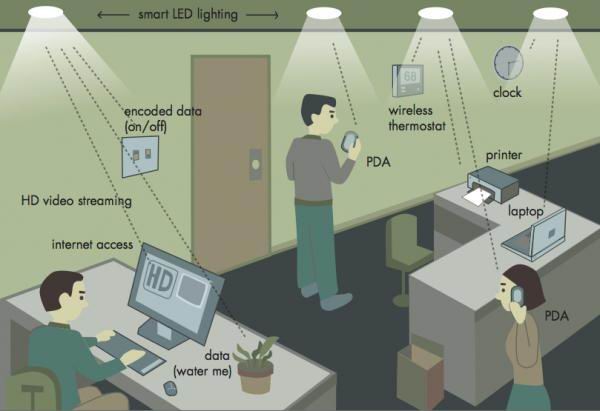Here is a technology which won't replace Wi-Fi: it will enhance it.
As silly as “Beam me that file, will you?” sounds, a data transfer technology developed by Estonian startup Velmenni, called Li-Fi, in 2011, could finally find real-life applications soon, in the wake of recent lab tests, showing speeds 100 times faster than Wi-Fi.
The inventor of Li-Fi, Harald Haas, a professor at the University of Edinburgh, Scotland, has demonstrated how LED lights can transmit more information than a cell phone communication tower, which translates into upwards of 224 gigabits per second, or roughly 20 feature films, each one being downloaded in one second flat.

The working principle of this technology, is based on Visible Light Communication (VLC), a method that uses visible light using a frequency between 400 and 800 Terahertz, and it’s described as a sophisticated form of Morse code. In simple terms, ones and zeroes of which data is made, are communicated using light and dark states, flickering as incredible speeds.
Those who may be wondering about the side effects of having high-speed flickering lights all day long, will find solace in the fact that the frequency at which these VLC bulbs flicker, is far faster than the human eye can detect, which rules out any potential occurrence of anaphylactic seizures.
Use cases
Since VLC requires direct line of sight between two endpoints, in order to communicate, VLC requires a completely different approach to wireless communication, and the likelihood of this technology to replace Wi-Fi for regular consumers, is next to none. However, VLC’s biggest drawback is also VLC’s greatest strength. Since VLC cannot send data through walls like Wi-Fi, those concerned with security can breathe a sigh of relief, knowing that their Li-Fi can’t be hacked from an outside intruder.
This fact alone makes the case for numerous applications, especially in the corporate sector, and in government buildings, in which wired communication is still the only way to shield data from intruders. Since Li-Fi is a lot more secure than Wi-Fi, and can even be embedded in light fixtures, it’s very plausible that corporations and government entities could consider it as a valuable enhancement to their networks.
With that said, real life applications are actually beginning to surface. French tech company Oledcomm is working on providing Li-Fi to local hospitals, and Haas’ own startup are also working on providing a plug-and-play product designed to deliver secure wireless access, called PureLiFi, with speeds up to 11.5MB per second.
How long before your PC or Mac supports Li-Fi?
All things considered, the cost of native support for Li-Fi on Windows 10 PCs and MacBooks may weigh a little too much on price tags, for a technology that may take more than some getting used to, for the majority of users. For most consumers, the convenience of Wi-Fi is hard to give up, even in the face of lower security. With that said, a plug-and-play option, sold separately, could be in the cards, perhaps baked into future Apple Mac accessories, iOS devices, and future Microsoft Surface Dock’s.